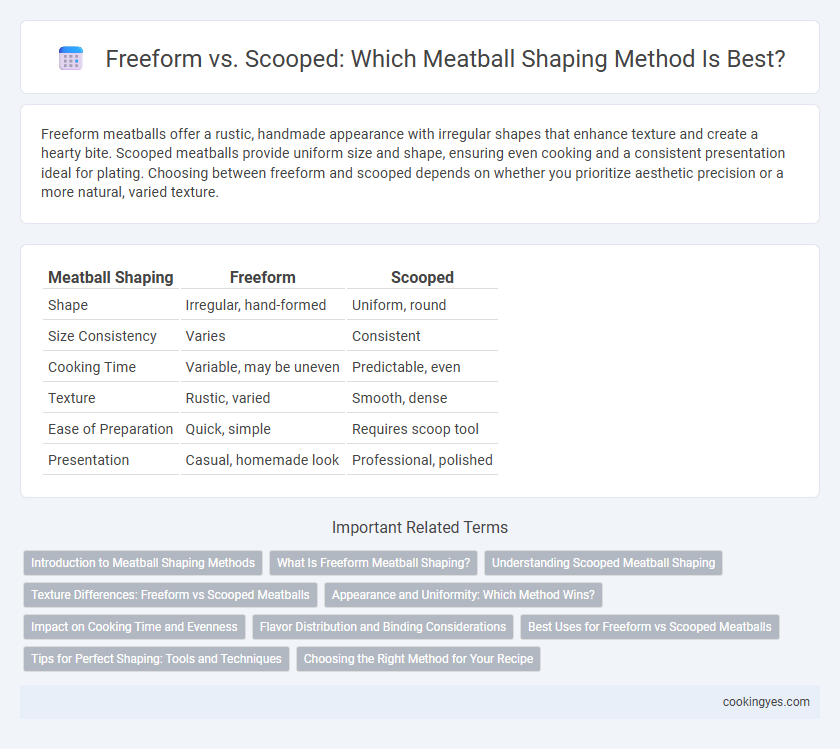Freeform meatballs offer a rustic, handmade appearance with irregular shapes that enhance texture and create a hearty bite. Scooped meatballs provide uniform size and shape, ensuring even cooking and a consistent presentation ideal for plating. Choosing between freeform and scooped depends on whether you prioritize aesthetic precision or a more natural, varied texture.
Table of Comparison
| Meatball Shaping | Freeform | Scooped |
|---|---|---|
| Shape | Irregular, hand-formed | Uniform, round |
| Size Consistency | Varies | Consistent |
| Cooking Time | Variable, may be uneven | Predictable, even |
| Texture | Rustic, varied | Smooth, dense |
| Ease of Preparation | Quick, simple | Requires scoop tool |
| Presentation | Casual, homemade look | Professional, polished |
Introduction to Meatball Shaping Methods
Freeform meatball shaping involves rolling ground meat mixtures by hand into irregular, naturally uneven shapes, which allows for varied textures and faster cooking due to increased surface area exposure. Scooped shaping uses a standardized spoon or ice cream scoop to create uniform, perfectly round meatballs, enhancing consistent cooking times and presentation. Both methods impact the meatball's moisture retention and browning, making the choice essential for recipe outcomes and desired textures.
What Is Freeform Meatball Shaping?
Freeform meatball shaping involves rolling ground meat loosely with hands without using molds or scoops, resulting in irregular, rustic shapes that cook unevenly for varied texture. This method allows for flexibility in size and is often preferred for traditional recipes where a rough surface enhances sauce absorption. Chefs favor freeform shaping to create meatballs with a homemade appearance and tender interior.
Understanding Scooped Meatball Shaping
Scooped meatball shaping involves using a spoon or scoop to portion out uniform portions of ground meat, ensuring consistent size and even cooking. This technique helps maintain the meatball's shape during the cooking process, reducing the risk of falling apart compared to freeform shaping by hand. Consistency in size from scooping also improves presentation and helps achieve a balanced meat-to-binder ratio in every meatball.
Texture Differences: Freeform vs Scooped Meatballs
Freeform meatballs tend to have a rustic texture with irregular surfaces that create a combination of crispy edges and tender interiors, enhancing flavor absorption during cooking. Scooped meatballs offer a uniform shape and density, resulting in consistent cooking and a smoother, more compact texture throughout. Texture differences influence moisture retention and mouthfeel, with freeform yielding varied bites and scooped providing a predictable, cohesive experience.
Appearance and Uniformity: Which Method Wins?
Freeform meatball shaping creates an irregular, rustic appearance with varied sizes, offering a homemade charm but less uniform cooking. Scooped meatballs, shaped using a portion scoop, deliver consistent size and shape, ensuring even cooking and a polished presentation. For uniformity and a professional appearance, scooped meatballs are the superior method.
Impact on Cooking Time and Evenness
Freeform meatballs cook faster due to their irregular shape, allowing more direct heat exposure and quicker moisture evaporation, but they often result in uneven cooking and inconsistent texture. Scooped meatballs, typically formed using a standard-sized scoop, promote uniform size and shape, ensuring consistent cooking times and even heat distribution throughout each meatball. Choosing scooped meatballs enhances predictability in cooking time and produces a uniform texture, crucial for recipes requiring precise doneness.
Flavor Distribution and Binding Considerations
Freeform meatballs allow uneven texture that enhances flavor pockets, giving a rustic bite but may result in inconsistent binding, causing crumbling during cooking. Scooped meatballs offer uniform size and shape, promoting consistent cooking and evenly distributed flavor, with better binding due to compact density. Choosing between freeform and scooped depends on desired texture and how well the binding ingredients like egg or breadcrumbs are integrated.
Best Uses for Freeform vs Scooped Meatballs
Freeform meatballs offer a rustic texture and uneven shape, making them ideal for home-cooked dishes where a homemade appearance enhances the appeal, such as in hearty stews or traditional spaghetti and meatballs. Scooped meatballs deliver uniform size and shape, ensuring even cooking and consistent presentation, which is preferred in restaurant settings or when serving large groups. Choosing between freeform and scooped meatballs depends on whether the priority is aesthetic consistency or a more natural, varied texture.
Tips for Perfect Shaping: Tools and Techniques
Freeform meatballs create a rustic texture by hand-shaping with slightly moist hands to prevent sticking while maintaining a natural, uneven surface ideal for absorbing sauces. Scooped meatballs achieve consistent size and even cooking through tools like a cookie scoop or ice cream scooper, ensuring uniformity and ease of portion control. For perfect shaping, chill the meat mixture briefly to firm it up before shaping and lightly wet or oil hands to keep the meatball from crumbling.
Choosing the Right Method for Your Recipe
Freeform meatballs offer a rustic texture and are ideal for recipes requiring irregular shapes, enhancing sauce absorption. Scooped meatballs create uniform sizes, ensuring even cooking and consistent presentation, perfect for formal dishes or batch preparation. Selecting the right shaping method depends on your recipe's cooking time, desired texture, and aesthetic preference.
Freeform vs Scooped for Meatball Shaping Infographic

 cookingyes.com
cookingyes.com